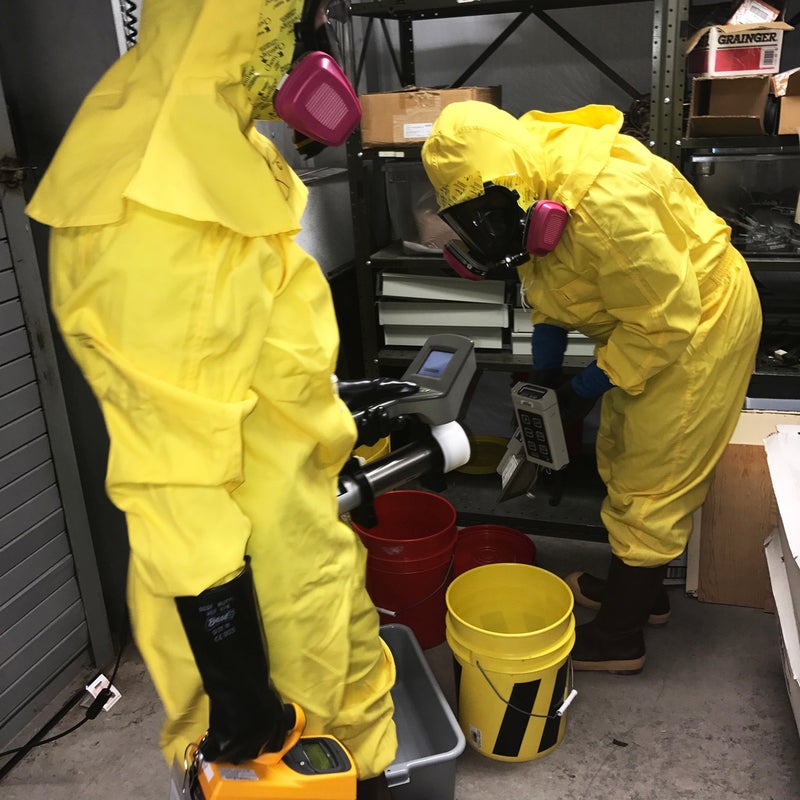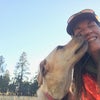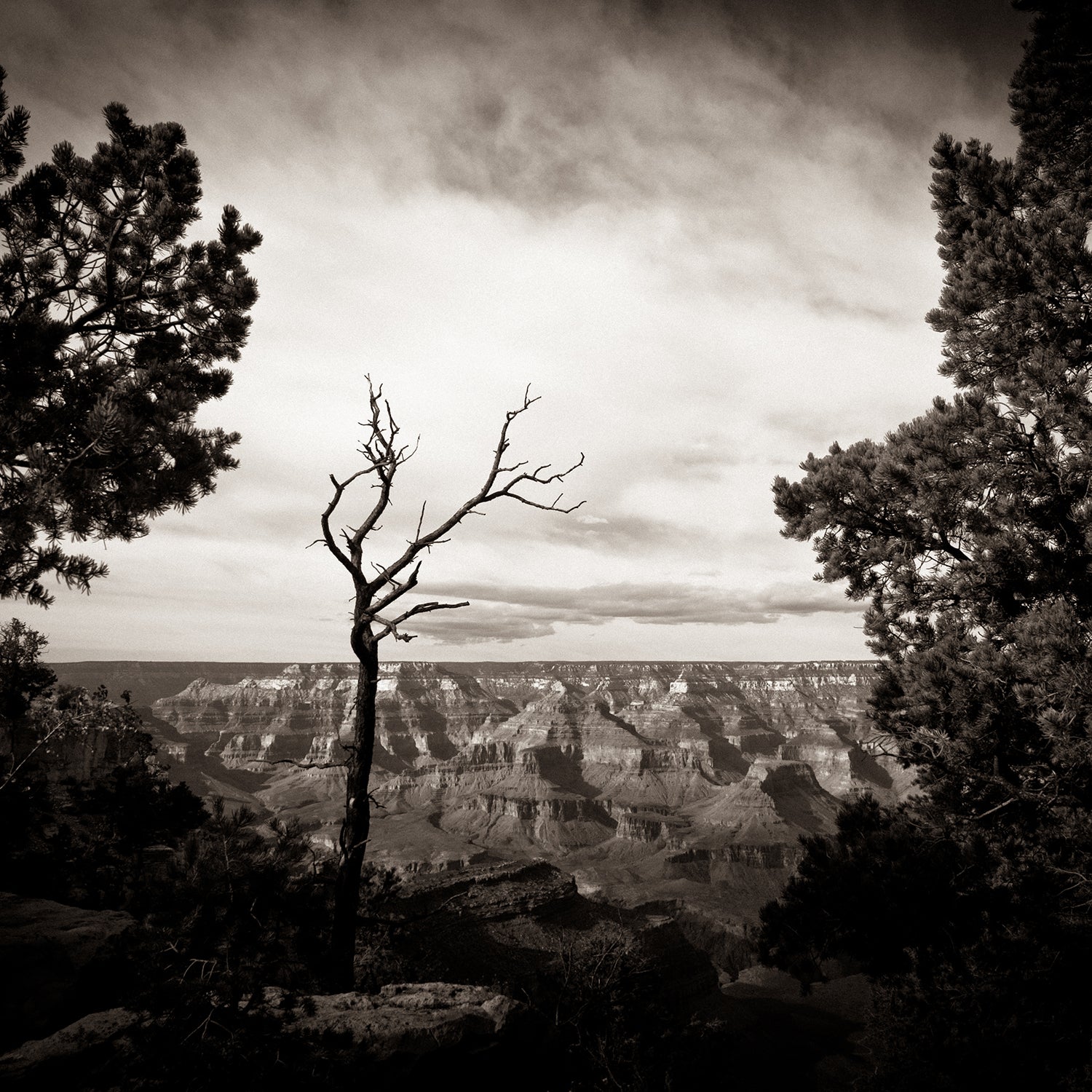On December 31, 2018, Elston Stephenson, the safety, health, and wellness manager for Grand Canyon National Park, emailed then interior secretary Ryan Zinke with a dire warning: “Sir, regrettably, it is not hyperbole to say that based on exposure rates and number of victims, Grand Canyon National Park may have suffered one of the worst nuclear incidents in the Nation’s history.” The message was referring to three buckets of uranium ore found seven months earlier in a Museum Collection facility about a mile from the park’s headquarters.����
A little over a month later, on February 4, 2019, Stephenson sent a memo to park employees: “If You were in the Museum Collections building between the year 2000 and June 18, 2018, you were exposed to uranium by the OSHA [Occupational Safety and Health Administration] definition.”
On February 18, the news went viral when the Arizona Republic ran a story with a : “Grand Canyon tourists exposed for years to radiation in museum building, safety manager says.” Stephenson had contacted the paper, claiming that park officials were trying to hide the information about the uranium ore.
Despite the juicy headlines, the National Park Service’s Intermountain Regional Office (IMR) had notified Stephenson and the park’s senior leadership in August 2018 that the issue had been resolved when the ore was removed from the museum collections building by the IMR’s radiation safety officer, who was sent to the scene in June to deal with it.
Preliminary findings from the Park Service’s investigation into the claims of radiation exposure, released last March, concluded that there was “no current uranium ore exposure.” The problem, according to the full , released in July, was that the radiation safety officer’s radiation-measuring device was incorrectly calibrated, causing elevated readings. There was never any risk of radiation exposure from the buckets of ore in the museum collections facility.
The uranium debacle was another loose boulder in a constant rockslide of problems at the Grand Canyon. Three years earlier, the park was scandalized when an investigation by the Department of the Interior (DOI) revealed a long-standing culture of bullying and sexual harassment there. Chris Lehnertz was named superintendent in the wake of that crisis, with a mandate to fix the park’s toxic culture.����
But in October 2018, Lehnertz was temporarily reassigned while the DOI’s Office of Inspector General (OIG) launched an investigation into what ultimately turned out to be baseless accusations made against her. She was scheduled to return to her post on February 20, 2019, but the false claims driving the uranium panic proved to be the last straw. Instead she chose to retire—the person hired to bring order to the chaos had been swept away by it.
Lehnertz started at the Grand Canyon in September 2016. As the park’s first female and openly gay superintendent, her motto was: “Grand Canyon’s priority is to create a respectful and inclusive workplace.” She implemented a novel management approach that sought to heal a traumatized workforce, weed out bullies, and make employees feel safe to speak up. But not everyone embraced her methods, which were designed to protect workers from retaliation and hostility.
The complaint filed against Lehnertz in October 2018 charged that she “created a hostile work environment and engaged in bullying and retaliatory behavior against senior leaders, particularly male leaders.” Although names in the official report from the inspector general’s investigation into the allegations against her were withheld, documents shared with �����ԹϺ��� by senior executives at the park show that the complaint was filed by Grand Canyon deputy superintendent Brian Drapeaux. (When reached for comment about the complaint, Drapeaux said he could not “discuss any personnel-related issues as they are protected by law, and any breach could jeopardize the careers of those that divulge this type of protected information.”)
The uranium debacle was another loose boulder in a constant rockslide of problems at the Grand Canyon.
Drapeaux had been transferred to the Grand Canyon and made deputy superintendent there in 2014, while he was being as chief of staff for the Bureau of Indian Education. (The investigation found ethics violations relating to a contract awarded to a former employer and retaliation taken against an employee who objected to the conflict of interest.) He temporarily served as Grand Canyon superintendent during Lehnertz’s reassignment and after she resigned.
The inspector general’s investigation exonerated Lehnertz of the allegations made against her. At the same time, it also documented shortcomings in Drapeaux’s performance. It described Drapeaux’s failure to complete tasks and attend meetings on a “high priority park initiative.” The investigation also revealed that he refused to conduct a review of an employee he managed as required under his job duties. “I will not provide it to [Lehnertz] so that she can use it as a weapon,” he told investigators, stating that he believed Lehnertz wanted to fire the employee. The investigation also found that Lehnertz was justified in giving Drapeaux a one-day suspension for his failure to evaluate the employee. Documents shared with �����ԹϺ��� show that the employee not getting properly reviewed was the park’s safety manager, Stephenson.
The uranium ore that triggered the latest scandal came from the Orphan Mine, which operated in Grand Canyon National Park from 1956 to 1969. It was brought to the park’s Museum Collections building in 2000 as part of an effort to document park history and sat in buckets near a taxidermy cabinet where thousands of visitors passed by over the years on tours of the facility.
While dust from the ore can be dangerous to human health, the actual rocks emit very low amounts of radiation—no more than a person would be exposed to when hiking in the Grand Canyon. A study conducted in 2000 confirmed that radiation readings from the uranium-ore samples in the Museum Collections building were no higher than background levels in the rest of the park.
After learning about the buckets of ore in June 2018 during the park’s annual safety, health, and environmental audit, Stephenson, the park’s safety manager, contacted the IMR for on-site technical assistance. The IMR dispatched a radiation safety officer, who arrived three days later.
When the IMR radiation safety officer waved his radiation detector over the buckets, the readings were above background levels, so he advised that they be removed. Grand Canyon senior staff would not receive the actual data from the safety officer’s readings for two more months, but given his professional background and role within the Park Service, the staff trusted his assessment and followed his recommendation to resolve the situation. (The safety officer and park staff did not know at the time that the radiation-measuring device was incorrectly calibrated and that there was no actual health risk posed by the buckets with the ore.)
Federal protocol for dealing with radioactive mine waste specifies that the buckets should have been put in a designated hazmat locker at the park and a company specializing in radioactive waste hired to retrieve and dispose of the ore at an EPA-approved site outside the park.
Instead, according to the Park Service investigation into the claims of radiation exposure conducted last spring and , the safety officer and his wife, a certified radiation-technician contractor, used plastic dishwashing gloves and a mop to transfer the toxic materials from the museum collections facility to the Orphan Mine, now a Superfund site. Stephenson went along to help. Wearing the gloves, the radiation safety officer picked up the buckets with the mop handle and hoisted them into the bed of Stephenson’s truck. Park staff instructed the safety officer to leave the ore in the buckets at the mine site to adhere to , but the officer decided to bury the rocks so they weren’t visible. Then he rinsed out the plastic paint buckets and returned them to the building.
On August 13, 2018, the IMR released the findings from the radiation readings taken at the Grand Canyon Museum Collections building two months earlier. The private memo was sent to Lehnertz, Drapeaux, and Stephenson. The report stated the “results were positive for radioactivity above background.” However, because the rocks had been subsequently removed, the report implied that the issue had been resolved.
Why was no additional action taken last summer after seeing the elevated readings? “Uranium ore rocks generally pose a low-risk hazard. NPS management believed that no immediate further action was needed,” Marco De Leon, public affairs chief for the IMR, explained in an email to �����ԹϺ���. He also noted that Park Service managers were relying on the measurements from the 2000 study rather than the “hasty” survey conducted in June 2018.
The next step was for the park’s senior staff to draft a response to the safety audit, a task Lehnertz assigned to Drapeaux and Stephenson. But the response was never submitted. In October, Lehnertz was suddenly reassigned when the inspector general opened its investigation into Drapeaux’s accusations.
Despite the IMR’s conclusion that the uranium ore posed no danger, Stephenson came to believe otherwise, based on the erroneous readings taken in June by the IMR radiation safety officer. With Lehnertz absent due to the inspector general’s investigation last fall, he reported the erroneous readings from the June 2018 inspection to OSHA. As Stephenson’s boss, Drapeaux was responsible for reviewing such claims before they were shared. (Both Drapeaux and Stephenson, when reached by �����ԹϺ���, declined to comment on the decision to contact OSHA.)
Staff from OSHA’s Phoenix office made a surprise visit on November 28, 2018. Wearing head-to-toe hazmat suits, they waved their monitors around the Museum Collections building as terrified staff looked on. Everything registered normal except a slightly elevated reading from the area around the empty plastic buckets, which were then removed.

Protected from losing his job by federal whistleblower laws, Stephenson forged on. In a December 19 email to Zachary Barnett, the director of Arizona’s OSHA office, Stephenson said: “Zach, the numbers are off the charts. I believe with respect to both the numbers in and of themselves, and the attempts at covering up and denying this information to employees, we are in criminal conduct territory.”
In addition to emailing Zinke shortly after the OSHA inspection, Stephenson also contacted the Nuclear Regulatory Commission, the Arizona Department of Health Services, the FBI, and every member of Congress.
Things cooled during the government shutdown last winter. But once Grand Canyon employees were back at work in early February, Stephenson sent out his warning to park staff. He also described how Park Service officials had tried to hide the readings, how he sought outside help, and how the public must be notified. Shortly after that, he contacted the Arizona Republic.
Instead of sending out press releases about the Grand Canyon’s centennial celebration, park spokesperson Emily Davis worked to tamp down public alarm. “There is no current risk to the park employees or public,” she insisted in the Arizona Republic article. Requests for calm took a back seat. Park Service officials provided no evidence at the time to counter Stephenson’s claims, despite the IMR’s conclusion in August that the problem had been resolved and OSHA’s inspection in December.
After the Arizona Republic story came out, the Park Service announced its official investigation of the uranium found in the Museum Collections building. De Leon told �����ԹϺ��� that it was also the first time the agency took a closer look at the elevated numbers found by the IMR radiation safety officer the previous June. “NPS experts conducted an additional internal review of the 2018 site-visit trip report, observed that readings appeared unusually high, and informed management the readings were likely inaccurate,” said De Leon. He added that it was “out of an abundance of caution” that the Park Service then commissioned a study to get an additional third-party opinion, from Aecom Technical Services.����
�����ԹϺ��� asked Mark Loeffler, a physicist at Northern Arizona University who studies radiation effects, to evaluate the Park Service conclusions from the study. “I agree with the Grand Canyon safety and health-review team’s assessment,” said Loeffler after comparing the data from various reports. “They were pretty transparent about correcting the mistake made by the radiation safety officer. There is nothing for me to suspect they are hiding anything.”
Preliminary results from the Park Service’s third-party study of possible uranium contamination at the Grand Canyon Museum Collections building were and confirmed that the safety officer’s readings were erroneous. (The Arizona Republic followed up its reporting with the details of those findings as well as the report from the full investigation that was released .)
According to sources close to her, the uranium scandal was the last straw for Lehnertz in terms of tolerating what she claims were false allegations aimed at sabotaging her ability to lead.
Lehnertz requested that senior officials at the DOI give her authority to reel in Grand Canyon employees sending out false statements, but the DOI told her that she could not take disciplinary action against them once she returned to the park because of the possible perception of retaliation, according to documents obtained by �����ԹϺ���. She was told this despite Drapeaux’s failure to fulfill required job duties as documented in the inspector general’s investigation of his accusation against Lehnertz as well as his and Stephenson’s failure to complete their responsibilities regarding the 2018 safety-audit response.����
“Chris is not safe there,” Lehnertz’s attorney, Kevin Evans, told �����ԹϺ��� in March. He was representing Lehnertz in an attempt to negotiate acceptable conditions with the DOI for her return to the park.
According to sources close to her, the uranium scandal was the last straw for Lehnertz in terms of tolerating what she claims were false allegations aimed at sabotaging her ability to lead. She ultimately decided to retire rather than go back to a job where she believed some senior managers were maligning her with impunity.
Since her resignation, anger and confusion have swirled like dust devils at the Grand Canyon. “Chris was the leader that Grand Canyon needed,” lamented one former Grand Canyon employee, who asked to remain anonymous and transferred to another park due to what they deemed as hostile working conditions. “The systems that were put in place to protect employees are instead being abused by bad actors.”
A longtime senior executive at the Grand Canyon, who also asked to remain anonymous for fear of retaliation, attributed the uranium debacle to a lack of leadership that allowed dysfunction to spread. For most of the past year, the DOI, Park Service, and the IMR have all had acting directors. And the Grand Canyon has had a rotating cast of acting superintendents.
“Employees at Grand Canyon who want to do the right thing get squashed, and employees who want to do wrong suffer no consequences,” said the executive. “The good news is most Grand Canyon employees get up every day and do their jobs anyway, because they have a higher calling.”


